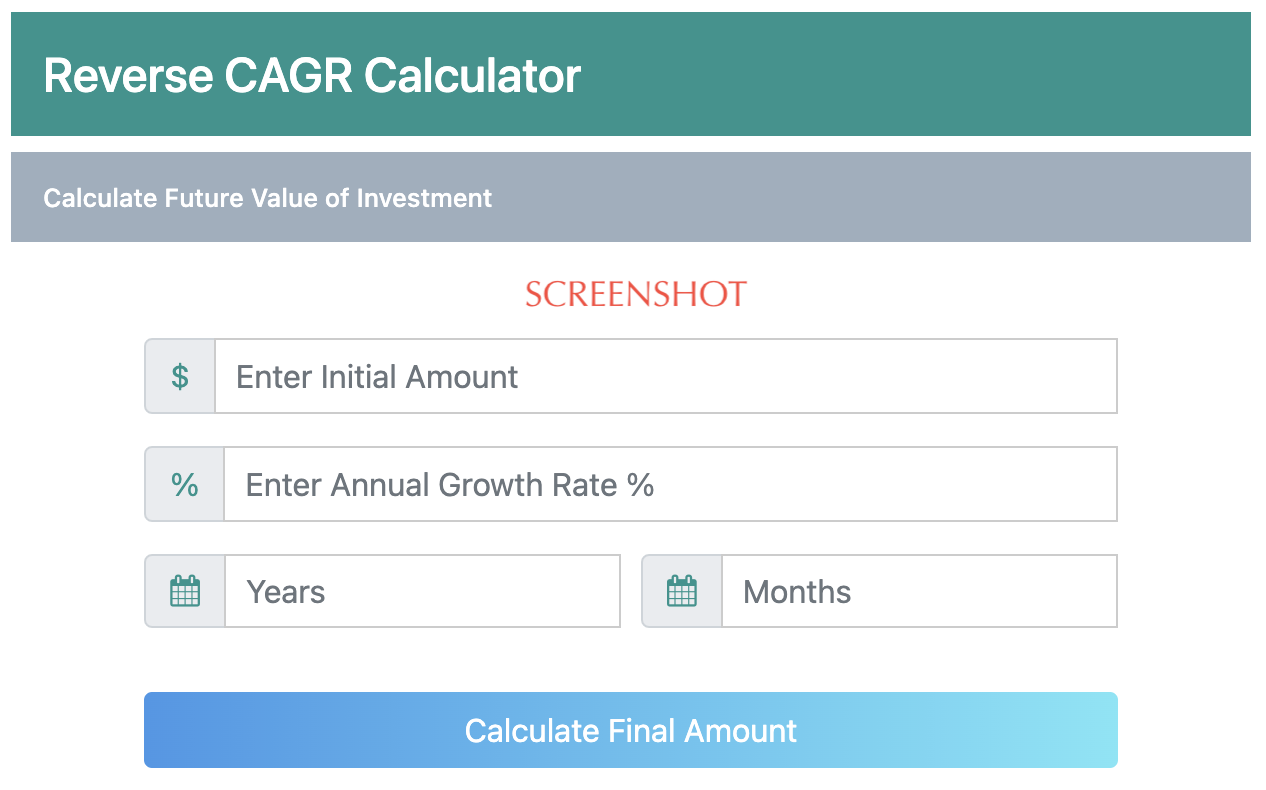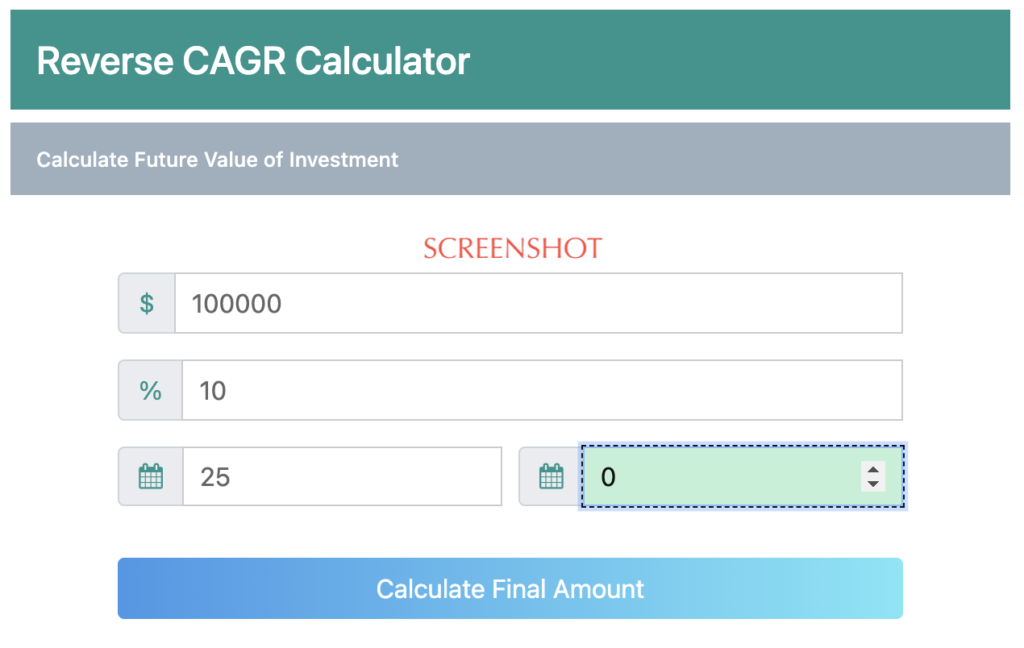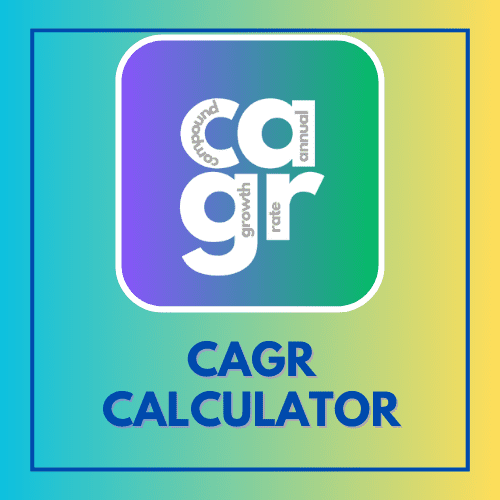CAGR: What is CAGR?
Even before we dive deep into a reverse CAGR Calculator, let’s understand CAGR first.
The full form of CAGR is Compound Annual Growth Rate.
When an investment grows over a multi-year period, it is important to understand the overall growth, but it is also important to understand the annual rate of growth so that it can be compared to other investments.
In simple words, CAGR is a way to standardize and measure growth rate on an annual basis.
What is a Reverse CAGR Calculator?
A reverse CAGR calculator is a tool to calculate the future value of an investment when the rate of growth is known to us.
It can be helpful in estimating the growth of an investment at some time in the future by making some assumptions about the average annual growth rates. It can be used for various purposes such as making investment decisions and retirement planning.
In order to calculate the future value in a reverse CAGR calculator, we need to input the following information – the initial amount (or the starting value), the average annual rate of growth (the CAGR), and the time period for which the amount will stay invested.
How To Calculate Future Value by Using Reverse CAGR Calculator Online?
Let’s take a look at how to calculate the future value of investment online by using our Reverse CAGR Calculator.
Suppose I have $100,000 to invest today. I can keep the money invested, untouched, for the next 25 years. I want to invest the money in the stock market and I am expecting an average annual return of 10% per year for the next 25 years.

Step 1: Input the value for ‘Initial Amount’ or ‘Starting Value’ of the Investment.
Let’s say the initial amount is $100,000 (you don’t need to input thousand’s separators).

Step 2: Input the Average Expected Annual Growth Rate (CAGR)
Let’s say we are expecting the investment to grow at an annual rate of 10% per year on average in the future.

Step 3: Enter the Time Period For Which The Money Will Stay Invested
Let’s say we want to keep the money invested for 25 years (+0 months), untouched.

Step 4: Once all values are filled, hit the ‘Calculate Final Amount’ button.
Once you click the ‘Calculate Future Amount’ button, you immediately get back a response on the web app.

There you have it, the Future Value = $1,083,470 or simply $1.083 Million.
In this case, we see that an investment of $100,000 can grow into over $1 Million over a period of 25 years, at a growth rate of 10% compounding annually.
Reverse CAGR Formula To Calculate Future Value
The reverse CAGR formula can be used to calculate the future value of an investment:
How do you calculate CAGR backwards?
You can just use the same equation we have used in the CAGR Calculator, and rearrange the items to bring the Future Value or Final Amount to one side.

Future Value = Present Value * (1 + CAGR) ^ [no. of Years]
Future Value Calculation Example, Using the Reverse CAGR Formula
We can use the Reverse CAGR Formula to compute the Future Value of an investment.
Suppose I have $100,000 to invest today. I can keep the money invested, untouched, for the next 25 years. I want to invest the money in the stock market and I am expecting an average annual return of 10% per year for the next 25 years.
Using this information, we can calculate the Future Value.
Here,
- initial amount = $100,000
- CAGR = 10%
- years = 25
Using the Reverse CAGR formula (100,000) * (1 + 10/100) ^ 25
We get the answer Future Value = $1,083,470
So, based on the expected growth rate of 10%, my $100,000 investment will grow into $1.083 Million in 25 years, i.e., the Future Value of my $100 K investment is $1.083 Million.

If we break down the growth of investment year by year, we can see how a modest-looking growth of 10% per year, can grow the investment 10-fold in just 25 years, from $100 K to over $1 Million!
How To Calculate Future Value in Excel
Calculating Future Value in Excel is very easy. You just have to input three values (present value, CAGR, and no. of years) in 3 different cells, and put the reverse cagr formula in a different cell.
Let’s use the same numbers as used in the previous example.

For example, in this screenshot, I have set up the Future Value calculation this way:
- Cell C4: Initial amount or Present Value: 100,000
- Cell C5: CAGR or Annual Growth Rate: 10 (for 10%)
- Cell C6: No. of years: 25
I have then put the reverse CAGR formula for calculating Future Value in Excel in cell C8
- Cell C8: =C4 * (1 + C5/100 ) ^ C6
Using the ‘=’ sign tells Excel that the cell contains a formula and then Excel references and uses the numerical values in cells C4, C5, and C6 and applies the reverse CAGR formula to show the result.
The result shown in this case is 1083470.594
To represent the answer in easy-to-understand dollar terms, I copied the value in cell C9, and changed the format of the cell to “$”. So, the answer is $1,083,471
How To Calculate Future Value in Google Sheets
Calculating Future Value in Google Sheets is very easy. You just have to input three values (present value, CAGR, and no. of years) in 3 different cells, and put the reverse cagr formula in a different cell.
Let’s use the same numbers as used in the previous example.

For example, in this screenshot, I have set up the Future Value calculation this way:
- Cell C4: Initial amount or Present Value: 100,000
- Cell C5: CAGR or Annual Growth Rate: 10 (for 10%)
- Cell C6: No. of years: 25
I have then put the reverse CAGR formula for calculating Future Value in Google Sheets in cell C8
- Cell C8: =C4 * (1 + C5/100 ) ^ C6
Using the ‘=’ sign tells Google Sheets that the cell contains a formula and then Google Sheets references and uses the numerical values in cells C4, C5, and C6 and applies the reverse CAGR formula to show the result.
The result shown in this case is 1083470.594
To represent the answer in easy-to-understand dollar terms, I copied the value in cell C9, and changed the format of the cell to “$”. So, the answer is $1,083,471
How To Calculate Future Value in Python
In Python, we can create a reverse CAGR function such as the following to calculate the Future Value, taking in the present_value, cagr, and years as inputs, and using the reverse CAGR formula.
def reverseCagrCalculator(present_value, cagr, years):
future_value = present_value * (1 + cagr/100) ** years
return future_valueOnce the function is defined, we can pass the value to the function and store the result in a variable ‘FutureValue’ and print it to see the answer.
FutureValue = reverseCagrCalculator(100000, 10, 25)
print(FutureValue)
As we can see, using the same numbers as previously, we get the future value = $1.083 Million.























